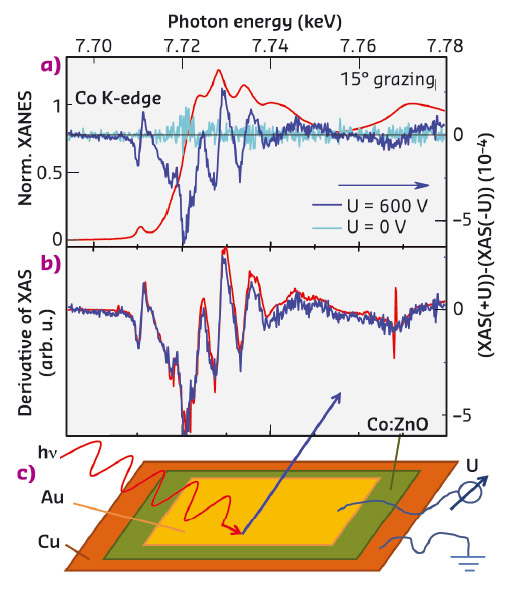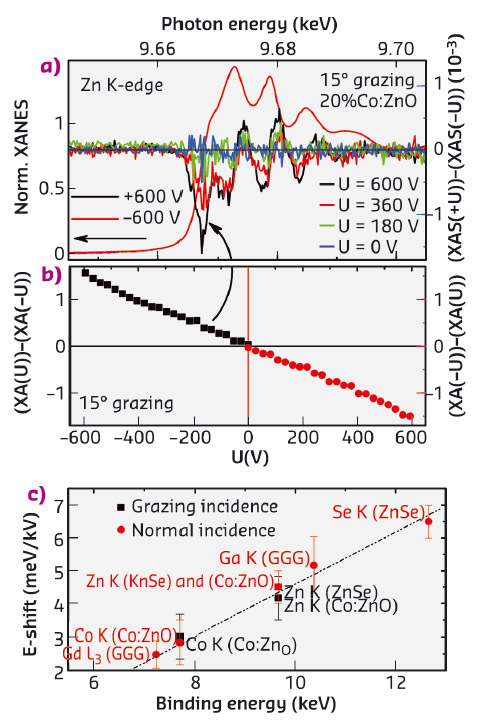- Home
- Users & Science
- Scientific Documentation
- ESRF Highlights
- ESRF Highlights 2016
- Electronic structure, magnetism and dynamics
- Element-selective measure of atomic polarisation by XANES in external electric fields
Element-selective measure of atomic polarisation by XANES in external electric fields
The electrical properties of functional electric materials can be studied using a new technique involving X-ray absorption spectroscopy. External electric fields were found to produce shifts of XANES spectra providing an element-selective measure of atomic polarisation originating from the permanent electric dipoles present in polar samples.
Electrical functionality of matter plays an important role in today’s technology. Functional electric materials have a variety of applications such as piezoelectric actuators used as injectors in car engines and ferroelectric materials within FRAM computer memory. Most functional electric materials exhibit permanent electric polarisation which can be manipulated by electric fields. To improve these materials, electric polarisation needs to be tailored at the atomic scale, and a measurement technique is essential to gauge results.
Absorption spectroscopy in electric fields has a longstanding history. Classical examples are the Stark-effect [1], where atomic energy levels in (non-)polarised materials shift linearly (quadratic) with the applied electric field. These classical optical experiments have now been brought to the synchrotron and the first X-ray absorption spectroscopy measurements in an electric field have been performed at beamline ID12. These experiments have revealed the potential of the technique to become a versatile approach to study atomic electrical properties with element selectivity.
 |
|
Fig. 16: a) Co K-edge XANES of 20% Co:ZnO recorded with and without electrical field and the respective difference signal. b) Difference signal in comparison with the derivative of the XANES. c) Schematic setup of the plate capacitor geometry. |
A range of prototypical samples was selected for this study, including the functional oxides cobalt-doped zincoxide (Co:ZnO) and gadolinium gallium garnet (Gd3Ga5O12; GGG) which are polar multi-constituent materials, i.e. the atoms in these oxides possess a permanent electric polarisation due to the low crystalline symmetry of the material. X-ray absorption near edge spectra (XANES) were recorded while applying an external voltage of up to 600 V along the polar direction of the material in a plate capacitor geometry that generates a strong electric field across the material (see Figure 16c for the setup). The experiment shown in Figure 16a reveals that there is a small difference of less than 0.1% between the XANES recorded at +600 V and –600 V at the Co K-edge of a 20% Co:ZnO sample as well as the control experiment at 0 V. The difference signal was compared with the numerical derivative of the XANES and found to be a perfect match (Figure 16b). It can be concluded, therefore, that the effect of the applied voltage is a shift in energy of the (unoccupied) electronic states that are probed in the XANES experiment. For a quantitative analysis, the difference signal can be made to disappear by artificially shifting the XANES (-600 V) in photon energy with respect to the XANES (+600 V). This analysis yields a shift of 2.8 meV (not shown). To demonstrate the element selectivity, the same experiment was repeated at the Zn K-edge of the same Co:ZnO sample. For these samples, it is known that Co substitutes for Zn without changing the crystalline structure of the ZnO host [2]. Figure 17a shows that the resulting difference signal decreases with decreasing applied voltage. Figure 17b demonstrates that, at a fixed photon energy, the resulting difference in X-ray absorption depends linearly on the applied voltage; a first indication that the observed effect is the X-ray variant of the linear Stark effect. Figure 17c is a compilation of the findings for all studied samples which reveal that the energy shift does not depend on the relative orientation of the synchrotron light and the applied voltage. Furthermore, the energy shift is the same at the Zn K-edge, no matter whether a Co:ZnO thin film or a zincselenide (ZnSe) single crystal is studied. In contrast, the shift is different for Co and Zn although both are contained in the identical Co:ZnO sample, which highlights the element specificity of the effect. Finally, it appears that the energetic shift depends linearly on the binding energy if all results for Co:ZnO, GGG(111) and ZnSe(111) are collected including the Gd L3-edge which, however, probes electronic states of a different symmetry.
 |
|
Fig. 17: a) Zn K-edge XANES of 20% Co:ZnO recorded with and without electrical field and the respective difference signal for different voltages. b) Dependence of the difference in X-ray absorption on the applied voltage at fixed photon energy. c) Dependence of the resulting voltage-induced energy shift on the binding energy of the absorption edge. |
These experiments involved samples where the voltage generated an electric field parallel to the polar direction of the specimen. Further control experiments on non-polar strontium titanate (SrTiO3) and on highly conducting aluminium-doped ZnO (a known transparent conducting oxide) confirm that no difference signal can be recorded in cases where the material is non-polar or when mobile carriers screen the electric field. This finally confirms that the X-ray variant of the linear Stark effect has indeed been observed, permitting electrical polarisation to be studied with element selectivity.
Principal publication and authors
X-ray absorption spectroscopy in electrical fields: an element-selective probe of atomic polarization, V. Ney (a), F. Wilhelm (b), K. Ollefs (b), A. Rogalev (b) and A. Ney (a), Phys. Rev. B 93, 035136 (2016); doi: 10.1103/PhysRevB.93.035136.
(a) Institut für Halbleiter- und Festkörperphysik, Johannes Kepler Universität, Linz (Austria)
(b) ESRF
References
[1] J. Stark, Annalen der Physik, 43, 965 (1914).
[2] A. Ney et al., J. Appl. Phys. 115, 172603 (2014).



